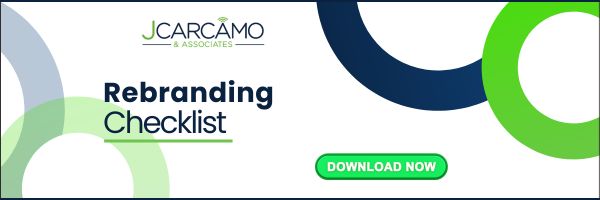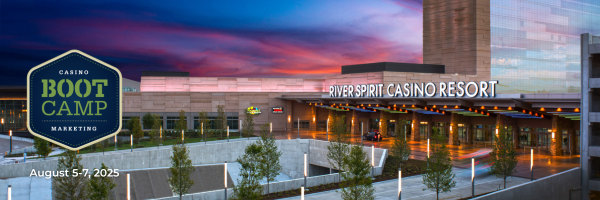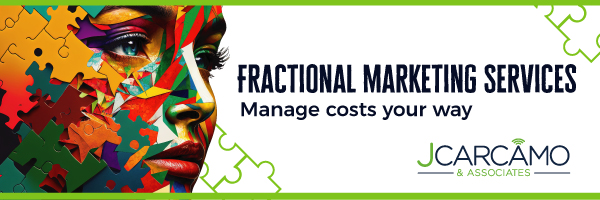A logo change is never just a logo change.
Picture this: You’ve just unveiled your casino’s sleek new logo to your executive team. Everyone loves it—modern, distinctive, perfectly capturing your vision for the property’s future. Then someone asks, “So when do we change the uniforms?” Another chimes in, “What about all the promotional items we just ordered?” The marketing director mentions website updates, while your operations head brings up the loyalty cards. Suddenly, your quick win turns into a massive checklist that touches almost everything—cards, chips, signage, kiosks, websites, loyalty cards, etc.
Your “simple” logo refresh has snowballed into hundreds of touchpoints requiring updates: playing cards, chips, directional signage, digital assets, billboards, employee name tags, promotional merchandise, point-of-sale systems, and more.
What started as a creative project is now a full-blown operations puzzle. That’s where a detailed rebrand checklist can be your best friend—saving time, money, and (let’s be honest) your sanity.

When Is It Time for a True Rebrand?
Let’s take a step back before you get too deep into to-do lists and color palettes. Do you actually need a complete rebrand or just a refresh?
Many casinos jump into logo changes, thinking that’s what will turn things around. But there’s a big difference between updating your look and changing your story.
A refresh is more of a glow-up:
- Tweak your colors or typography
- Modernize how things look online and on the property
- Keep the same voice and promise
A true rebrand? That’s deeper:
- You’re redefining who you are
- You’re shifting how you want to be seen
- And you’re realigning operations actually to deliveron a new guest experience
If your property is known for bingo and penny slots, but you’re pouring capital into a steakhouse and a high-limit room, you are not just changing the signage. You’re rewriting expectations, meaning you need a brand to match.
Common signs your casino needs a rebrand include an outdated identity that no longer resonates with today’s players, stagnant customer engagement, increased competition, or significant changes in ownership or management that signal a new direction for the property.
The Risk of Surface-Deep Rebranding
The most significant risk in rebranding isn’t that guests won’t recognize your logo. It’s that everything else stays the same.
We’ve all seen it: shiny new signs, slick new ads, but then the same old experience behind the curtain. That kind of surface-level rebrand? It doesn’t just fall flat—it creates a disconnect. Guests feel it. So does your team.
Ask yourself:
- Are your hosts trained to speak in your brand voice?
- Do your promotions reflect what you say you stand for now?
- Is your loyalty program still operating like it’s 2015?
- Are you showing up in the right channels for the guests you want to attract?
If the answer is “not yet,” it’s worth slowing down before you hit print on those new cards and chips.
A rebrand that runs only surface-deep creates cognitive dissonance for guests (and internal stakeholders) when their expectations don’t match reality. If you’re simply tired of your current look or want to generate some good press, those aren’t strategic reasons for a rebrand—they’re warning signs that you might be heading toward an expensive mistake.
Production Pitfalls and Budget Traps
Here’s where the headaches usually start—production.
Most marketing teams don’t have the luxury of unlimited budgets or armies of support. You’re managing a rebrand while still running promotions, building campaigns, and keeping the calendar moving. And now you’ve got to think about cardstock thickness and uniform embroidery?
Some of the most common traps we see:
Ordering Too Soon (or Too Late)
You finally approve the new designs and rush to print. However, a closet full of old brochures and loyalty cards is still waiting to be used. That mismatch turns into waste or confusion for guests.
Tip: Map out what you have in inventory. Plan when and how to swap things out. Not everything has to flip on day one.
Vendor Miscommunication
Embroidery colors don’t match, Signage gets printed with the wrong specs. Vendors don’t always know your brand standards, or they’re working off old files.
Tip: Create a simple visual guide. Include specs like Pantone, CMYK, RGB, and HEX. Show clear dos and don’ts. Don’t assume your designer’s files are plug-and-play for everyone else.
Digital-Physical Mismatch
Your website rebrands overnight, but physical materials take months to update, creating an inconsistent experience.
Solution: Plan a phased rollout with coordinated “reveal dates” for different touchpoints, ensuring critical clusters of guest experiences change simultaneously.
Technology Integration Challenges
Rebranding would be significantly easier if you only had to send your vendors a new logo file.
But if you’ve ever worked with third-party systems, you already know it’s never that simple. Between kiosks, POS terminals, player tracking, mobile apps, hotel check-in, and restaurant systems, your tech stack touches almost every part of the guest journey. And each one speaks a slightly different language.
Miss one? Your guests will notice.
Some common curveballs:
- Underestimating Lead Time: Vendors often need 8–12 weeks after they get the final files. If you assume it’s plug-and-play, you’ll scramble during launch week.
- Mismatch in File Specs: They may need specific file types, dimensions, or formats that your design team hasn’t prepared.
- No Testing Environment: Many systems can’t even be tested until they’re live, which makes mistakes feel painfully public.
- Surprise Contract Clauses: Some contracts charge for mid-term updates or require notice windows longer than your rebrand timeline allows.
How to Stay Ahead of the Tech Headaches
- Start Early: Have your first rebrand check-in with each vendor 6+ months before your launch date.
- Tailored Asset Kits: Don’t just send the complete brand guide. Prepare custom assets based on what each vendor needs.
- Test in Phases: Use sandboxes or staging environments to spot problems early.
- Read the Fine Print: Know what’s in your contracts. Budget for any upgrade or change fees now, not later.
- Appoint a Tech Liaison: Assign someone with project management chops and a basic tech fluency to be the go-between for your marketing and IT/ops teams.
What “True Rebranding” Looks Like
Think of a rebrand as a climb. At the bottom, you’re fixing what’s broken—outdated signs, clunky guest touchpoints, maybe even uniforms that don’t match who you are anymore. But if you stop there? You’ve just slapped on a fresh coat of paint.
The real magic happens when your brand starts to feel different. When guests pick up on your vibe without seeing your logo, you’re not just updating. You’re transforming.
A rebrand that transforms your casino must climb what we call the “brand ladder“—moving from functional improvements to emotional connections:
Functional Foundation
- Actual service improvements supporting your new brand promise
- Refreshed amenities and offerings that align with positioning
- Operational changes that deliver on your brand’s claimed differentiation
Emotional Connection
- Staff interactions that reinforce your brand personality
- Environmental elements that trigger desired emotional responses
- Marketing that emphasizes feeling, not just features
Self-Expression
- How does your brand help guests express their identity
- Community connections that reinforce belonging
- Status recognition that makes guests feel valued
When Planet Hollywood rebranded from the Aladdin in Las Vegas, they didn’t just change the logo. They renovated restaurants, retrained staff on a new service style, reimagined entertainment offerings, and shifted their entire marketing approach to attract a different customer segment.
Remember: implementing a successful rebrand requires going “all in”—you can’t simply change your logo and call it transformation. As one industry expert noted, you must deliver something genuinely new, not just the same experience with a new name.
Leading the Change: Team Alignment
Your team is your brand. Guests may see your logo, but people bring it to life. That means rebranding isn’t just about what’s printed or posted—it’s about what’s felt.
Before you roll things out to the public, rally your crew. Host a kickoff. Make it fun. Reveal the new look, explain the “why,” and let them try on the new uniforms (literally and metaphorically). If your team’s not behind it, no amount of glossy signage will make your rebrand stick.
Internal Brand Launch
Hold a “brand boot camp” before your external launch. Make it memorable and engaging, not just another staff meeting. Reveal new uniforms, share the new vision, and equip team members with language to describe the changes to guests. An internal rollout should be a celebration that excites employees to be brand ambassadors.
From Training to Empowerment
Move beyond mechanical training to true empowerment. When team members understand the “why” behind the rebrand, they can make on-the-spot decisions, reinforcing your new positioning.
Recognition and Reinforcement
Create recognition programs that celebrate staff who exemplify the new brand values. Share guest comments that mention elements of your new brand promise being fulfilled.
Making It Work for Regional Casinos
For regional and community-focused properties, rebranding requires special considerations:
Local Authenticity
A rebrand shouldn’t erase your casino’s connection to the community. Instead, find ways to strengthen local ties while evolving your image.
Competitive Differentiation
Regional markets often have multiple casinos targeting the same customer base. Your rebrand should establish clear blue water between you and nearby competitors.
Regular Communication
Local patrons who visit weekly will notice every change. Create a communication plan specifically for your regulars, involving them in aspects of the rebrand through focus groups or preview events.
Realistic Timelines and Budgets
If there’s one thing almost every casino underestimates about rebranding, it’s this: How long it takes and how much it costs.
We get it. Everyone wants a new look “by next quarter.” But meaningful change takes time, budget, and alignment across departments that don’t always move at the same speed.
Here’s a more realistic view of what you’re signing up for, based on how deep you plan to go.
6-Month Rebrand (Visual Refresh) – Great if your brand still means something, and you want to modernize the look.
This accelerated timeline works when your brand positioning remains solid, but your visual identity needs modernization. The key to success here is having a clear strategic direction from day one and limiting scope to essential touchpoints.
- Months 1-2: Strategy, design concepts, stakeholder approval
- Month 3: Design system finalization, vendor selection
- Month 4: Digital asset updates, priority signage production
- Month 5: Staff training, internal rollout
- Month 6: Public launch, marketing campaign
12-Month Rebrand (Moderate Repositioning) – You’re evolving—not just the look, but the messaging, tone, and feel.
The most common timeline for regional casinos, this approach allows for meaningful research and testing while maintaining momentum. The extended timeline accommodates vendor lead times and adequately prepares staff for operational changes.
- Months 1-3: Market research, competitive analysis, strategy development
- Months 4-5: Design exploration and stakeholder alignment
- Months 6-7: Design system finalization, vendor coordination
- Months 8-9: Priority production (digital, primary signage, uniforms)
- Month 10: Staff training programs, internal communication
- Month 11: Secondary production elements, soft launch preparation
- Month 12: Public launch and marketing campaign
18+ Month Rebrand (Complete Repositioning) – If you’re changing ownership, repositioning in the market, or opening a major expansion. This is your path.
For properties undergoing fundamental transformation—new ownership, major expansion, or complete market repositioning. This timeline allows for comprehensive research, stakeholder buy-in, and operational alignment that sustainable transformation requires.
- Months 1-4: Comprehensive research, strategy development, operational planning
- Months 5-7: Design exploration, testing, stakeholder alignment
- Months 8-10: Design system finalization, vendor selection and onboarding
- Months 11-14: Phased production rollout beginning with the highest-impact touchpoints
- Months 15-16: Comprehensive staff training, internal alignment
- Months 17-18: Final implementation, staged public launch
Budget Considerations
While every property is different, these general investment ranges will help set expectations. Budget planning is crucial because rebrand costs extend beyond design, encompassing research, production, training, and implementation management that many casinos underestimate.
Visual Refresh ($) – Perfect for tightening things up without shifting strategy.
Ideal for casinos with strong brand positioning that need visual modernization. This budget focuses on updating existing touchpoints without fundamental operational changes, making it the most cost-effective approach for properties with limited capital.
- Design services: $30,000-75,000
- Primary signage updates: $5,000-150,000
- Digital assets: $5,000-50,000
- Collateral and print could be minimal if it’s scheduled accordingly and you’re not sitting on extensive inventories.
- Implementation management: Often handled internally, external resources can be utilized for $5,000-$50,000.
Moderate Repositioning ($) – A strong middle ground for regional casinos looking to compete harder or evolve meaningfully.
The investment level most regional casinos choose when addressing competitive pressure or evolving guest expectations. This budget allows for meaningful research and strategic development while maintaining fiscal responsibility.
- Research and strategy: $30,000-100,000
- Design system: $15,000-150,000
- Environmental updates: $100,000-300,000
- Digital experience: $50,000-150,000
- Staff training: $25,000-75,000
- Implementation management: $50,000-100,000
Complete Repositioning ($$) – This is the level to expect when you’re building a whole new identity.
Reserved for properties undergoing fundamental transformation—new ownership, major market expansion, or complete competitive Repositioning. This investment level ensures comprehensive change that drives long-term market differentiation and revenue growth.
- Research and strategy: $100,000-250,000
- Design system: $150,000-350,000
- Environmental transformation: $200,000-1,000,000+
- Digital transformation: $150,000-500,000
- Staff training and culture alignment: $25,000-200,000
- Launch campaign: $100,000-300,000
- Implementation management: $50,000-250,000
Budget-Saving Tips:
- Phase implementation over multiple fiscal years
- Prioritize guest-facing touchpoints for immediate update
- Leverage existing maintenance budgets for branded upgrades
- Consider temporary solutions for expensive items with long lifespans
Is Your Casino Ready for a Rebrand?
Before embarking on a rebranding journey, knowing what you’re trying to accomplish is crucial. A rebranding must align with your business’s long-term goals and support your overall strategy.
Ask yourself these questions:
- Has your customer profile changed significantly in the past 3-5 years?
- Are you investing in amenities or experiences that don’t align with your current brand image?
- Do guests and staff describe your property differently than you aspire to be seen?
- Are competitors overtaking you in key segments where you previously dominated?
- Has your property undergone significant ownership or leadership changes?
If you answered “yes” to two or more, it might be time for more than a fresh coat of paint.
Consider conducting research with both internal and external stakeholders to understand:
- How customers relate to your current brand
- Whether your brand is distinguishable among competitors
- If employees understand and believe in your brand promise
- Whether your brand aligns with your business vision and mission
Technology Integration: The Hidden Complexity
Behind every successful casino rebrand lies a complex web of technology systems that must be updated, often involving third-party vendors with their own timelines and processes.
Key Systems Requiring Updates
Player Management Systems
- Player’s club cards and kiosks
- Mobile app interfaces
- Kiosks
- Backend admin dashboards
- Reports and analytics dashboards
Point-of-Sale Systems
- Receipt templates
- Digital displays
- Backend interfaces
- Kitchen/service displays
Property Management Systems
- Check-in interfaces
- Confirmation emails
- Digital room keys
- In-room entertainment and information systems
Website and Digital Ecosystem
- Website design and functionality
- Email marketing templates
- Social media assets
- Digital advertising frameworks
Organize every detail with a rebranding checklist that tracks all touchpoints, deadlines, stakeholders, and dependencies. A simple spreadsheet can be as effective as complex project management software, but the key is having one central document that everyone works from and can access if disaster strikes.
Your Next Steps
A successful casino rebrand requires strategic planning, operational alignment, and meticulous execution. It’s a significant undertaking that can transform your property’s performance when done correctly.
Before moving forward, assess whether your reasons align with strategic business goals rather than common reasons not to rebrand, like being tired of your current look, wanting to generate press, or simply copying competitors. The most successful rebrands address fundamental misalignments between brand promise and operational delivery.
If you’re considering a rebrand, here’s our best advice:
✅ Be clear on why you’re doing it.
✅ Know the difference between a refresh and a repositioning.
✅ Map out how your operations will back it up.
✅ Budget more than you think (in both time and dollars).
✅ Bring your people along for the ride—from vendors to valets.
Want some help figuring out whether it’s time for a complete rebrand or just a polish? Let’s talk. We offer a complimentary Rebrand Kickstart Call—no pressure, just a conversation to map out your goals, timeline, and what success would look like for your property.
Remember: A brand isn’t just your logo, fonts, or ads.
It’s the feeling people get when they walk through your doors. It’s the stories they tell their friends after they leave. It’s how your staff answers the phone or welcomes a guest.
When done right, a rebrand doesn’t just change how you look—it changes how you show up. And that’s where the magic happens.




Recent Comments